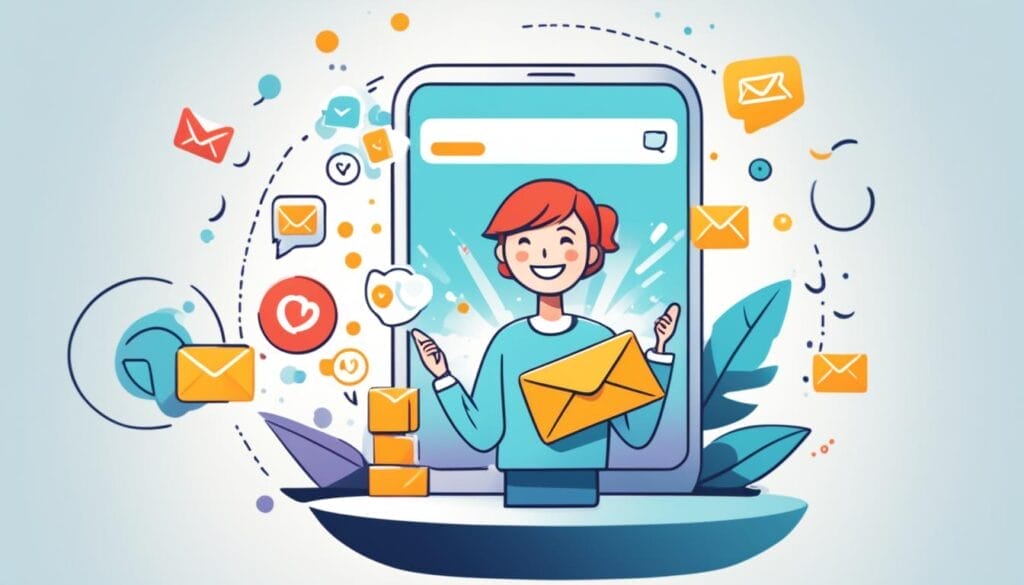Email marketing is key for reaching out to potential customers and increasing sales. With over four billion users, it can connect you with lots of people.
Nearly all users open their emails daily, showing it’s a very effective way to talk to them. It also brings a high return on investment, up to 4,200%. But just sending out ads is not the best approach now.
Email personalisation is crucial for engaging customers and boosting sales. When you use what you know about customers to send them custom messages, you can see better results. This includes open rates of 29%, click-through rates of 41%, and more customer interaction.
In this article, let’s go through some email personalisation strategies you can implement to help increase open rates.
Key Takeaways:
- Email marketing reaches over four billion users worldwide.
- Almost 100% of email users check their inboxes daily.
- Email personalisation can achieve open rates of 29% and click-through rates of 41%.
- Email personalisation is crucial for boosting engagement and driving sales.
- By using customer data, businesses can create tailored content that resonates with their audience.
What Is Email Marketing Personalisation and Why Does It Matter?
Email marketing personalisation means using customer data to send custom campaigns. It’s like how social media shows posts based on what users like.
Businesses can use this to connect personally with their customers. This makes email more than just saying ‘Hi, [Customer’s Name]’ in the subject line. It can involve things like offering deals on stuff they’ve bought before or showing them stores close by.
Even if it doesn’t work every time, sending personalised emails makes it more likely that someone will trust your company and buy something.
9 Email Personalisation Strategies to Implement in 2024
Personalised emails are a key way for companies to talk to their audience and get more sales. By using the latest personalisation tricks, you can get more people to open your emails and click on them.
I’ll share the top nine cutting-edge ways to make your emails more personal and effective in 2024 so you can beat your rivals.
- Collect quality leads: Find good leads by searching in Facebook and LinkedIn groups, and checking successful posts. Using lead magnets and forms on your website also helps. This way you’ll have useful information for personalisation.
- Segment your audience: Split your audience into groups based on age, shopping habits, and where they use your website. This makes sure you send them stuff that really interests them, which leads to more sales.
- Use hyper-personalisation techniques: Try advanced personalisation methods like using their name, their picture, and mentioning their local area. This makes each person feel like you’re talking just to them.
- Create personalised subject lines: Write catchy subject lines that are just for the receiver. This makes them more likely to open your email because it’s something directed at them.
- Collect and utilise customer data: Look at what your customers have bought before and suggest similar things. This makes shopping with you feel more personal and helpful.
- Use dynamic content: Put content in your emails that changes based on what your customer does. This way, the email is always up to date and super relevant.
- Send personalised emails based on customer milestones or events: Send special emails for things like birthdays or when they’ve been your customer for a year. It adds a personal touch and makes them feel valued.
- Implement seasonal email personalisation: Use emails to get people excited about seasons or holidays. This motivates them to act – whether it’s buying something or just visiting your website.
- Re-engage inactive subscribers: Focus on those who haven’t been active. Send them special offers to bring them back and show them what they’ve been missing.
By using these personalisation tips, you can transform your email marketing and see better results. Now, let’s look at how personalisation helps in eCommerce and in keeping customers loyal.
What is eCommerce Personalisation and Why is it Important?
eCommerce personalisation tailors the customer experience based on their activities. This includes what they look at and buy. It uses customer info like age, likes, and what they’ve bought before to suggest things.
This helps companies offer better recommendations and make shopping online more personal. In the eCommerce world, making things personal helps to keep customers loyal.
Research shows shoppers prefer stores that cater to them personally. When businesses make shopping personal, it builds a strong bond. This bond leads to happy customers who come back and tell others about their great experiences.
One perk of personalisation is matching shoppers with items they’ll love. By studying what customers like, stores can pick out things they’re likely to want. This makes shopping easier for the shopper and boosts the chance of a sale.
Also, personalisation boosts how much customers interact with the store. When stores send tailored messages or show products the shopper likes, they’re more likely to get involved.
This might mean checking emails often, visiting the site, or talking about the store on social media. These actions help more people learn about the store and keep its fans close.
eCommerce personalisation means more than smooth shopping; it’s about caring for customers. By tailoring suggestions and the shopping journey, stores can build lasting trust and boost their business steadily.
Personalisation ups the chances that people will buy and pay attention to their emails. Seeing their needs addressed directly in emails makes people much more interested. This boosts sales and gets more people to shop at the store.
For example, a clothing shop might learn that a customer loves eco-friendly clothes. They can then recommend eco-friendly items. This makes the shopping experience all about the customer. It more likely makes them want to shop there again.

The Importance of Customer Loyalty
Keeping customers is cheaper than finding new ones. Using personalisation can make customers feel like the brand really cares. This turns them into loyal fans.
Being made to feel special keeps customers coming back. Personalised deals or suggestions show that the brand is listening. This trust leads to extra shopping and people telling others about the brand.
Great experiences make people share the brand with others. Word-of-mouth is a powerful way to draw in new shoppers. This boosts the brand without the brand doing much of the talking.
eCommerce personalisation stands out in the shopping world. It helps stores know their customers better and sells more by doing so. By knowing what each shopper likes, stores can make real connections that matter.
9 eCommerce Personalisation Strategies That Work
Enhancing the eCommerce experience for customers is crucial. Let’s look at nine strategies to improve your eCommerce personalisation:
Make your homepage personal: Develop a friendly and customised homepage to draw customers in. Show them recommended products and special offers that fit their needs.
Give out personalised shopping guides: Guide customers in making smart buying choices with custom shopping guides. These guides, tailored to their preferences and history, will help them find the right products.
Introduce a chat option: Improve customer service and interaction by adding a chat feature. This lets customers talk to your support team directly, enhancing their shopping experience.
Recommend products tailored to the customer: Use customer data to suggest products they’re likely to enjoy. This approach increases the chance of customer satisfaction and finding what they need.
Use weather info for personalisation: Recommend products based on the customer’s local weather. This tactic makes shopping more relevant and convenient for them, which can lead to more sales.
Create custom campaigns: Personalise your marketing to suit different customer groups. By knowing your audience, you can create campaigns that really speak to them, boosting interest and sales.
Set up an exit-intent strategy: Attract customers with special offers just before they leave your site. This can entice them to stay and make a purchase.
Show recent items viewed: Show customers products they have looked at before. This can remind them of their interest and encourage them to buy.
Contact inactive customers: Try to reconnect with customers who haven’t bought anything lately. Sending them personal messages and special deals can bring them back to your site.
By using these strategies, you can create a shopping experience that feels unique and tailored for each customer. This will not only make customers happier but also increase sales and the success of your eCommerce business.
The Foundation of Email Personalisation
For effective email personalisation, businesses need to focus on vital elements. These include knowing their audience well. They should segment their audience by behaviour, demographics, and past purchases.
- Understanding your audience through segmentation based on behaviour, demographics, and purchase history.
- Implementing best practices in data collection and management, ensuring transparency and privacy compliance.
- Utilising personalisation technology, such as AI, to enhance email campaigns and automate tailored communications. This includes predictive analytics and individualised customer experiences.
It’s crucial to know your audience for good email personalisation. Segmenting them helps create better, more personal emails. You can send content and offers that your customers relate to. This boosts their interest and buying chances.
Good data collection and management are also key. Follow the best practices to keep customer data safe and accurate. Acting transparently and respecting privacy builds customer trust. It also lets you use their data wisely for a more personal touch.
Technology like AI really boosts your email game. It lets you predict what customers want and give them a unique experience. By tailoring emails automatically, you make the whole process smoother. This makes customers more likely to engage and take action.
By understanding your audience, handling data well, and using top tech, you lay a strong foundation for personal emails. This approach leads to campaigns that really speak to your audience. It can increase interest, sales, and customer care.
Benefits of Email Personalisation
Email personalisation gives businesses a boost, helping them stay ahead and get more clicks. Let’s look into why it’s great to use personalised emails:
- Higher Open Rates: Tailoring subject lines to what the audience likes can make a big difference. This can get people more interested, making them more likely to open up the email.
- Improved Click-Through Rates: When an email’s content matches what people are looking for, it’s more exciting. This leads to more clicks. And more clicks mean more visitors for the business.
- Enhanced Engagement and Customer Satisfaction: Sending emails that really speak to what the reader wants can build strong connections. It helps make customers feel they matter, making them happier with the business.
- Increased Revenue: Personalised emails can tip the balance, influencing buying decisions. By giving offers and suggestions tailored to the person, businesses can sell more, making better profits.
- Competitive Advantage: Standing out is crucial in today’s business scene. Personalised emails help create a unique and special bond with customers. It makes it easier to keep the old ones happy and to get new ones interested.
| Benefits of Email Personalisation | |
|---|---|
| Higher Open Rates | Increased chances of emails being opened due to personalised subject lines. |
| Improved Click-Through Rates | Increased engagement and traffic by tailoring content and subject lines. |
| Enhanced Engagement and Customer Satisfaction | Stronger connections and satisfaction through relevant and personalised campaigns. |
| Increased Revenue | Direct impact on driving conversions and sales through personalised offers. |
| Competitive Advantage | Differentiation by delivering tailored experiences and building strong relationships. |
Using personalised emails is a clever strategy for companies looking to improve their marketing. It’s not just about higher open or click rates. Personalisation makes customers happier, boosts earnings, and helps the business stand out.

Summing Up
Email personalisation is changing the way we do business online. It helps companies connect better with customers, boosting sales and loyalty. By crafting emails for each person, companies make sure their messages hit the mark.
To get this right, gathering good leads and dividing up the audience are crucial first steps. After this, offering custom advice and using the latest tech is key. These actions help make email marketing efforts pay off.
The perks of personalising emails are clear. They lead to more people opening and clicking on emails. This, in turn, increases how much customers interact and spend with the business. Email personalisation is a tool for companies to shine and win loyal customers.
And if you’re looking for an email marketing platform that easily integrates with your sales and marketing, we recommend Convertrr Digital Marketing software.
So, to sum up, if you aim to boost sales and improve your email marketing, personalisation is your best bet. Use smart strategies and the newest tech. Your audience will love the tailored messages, and your business will see more sales and loyalty as a result.
FAQ
What is email personalisation and why does it matter?
Email personalisation is about using customer details to make tailored content. This is sent in campaigns that target specific people. It’s more than using names.
It includes giving discounts and showing nearby stores. This method boosts interest from people, making them more likely to buy. It also keeps them engaged.
What email personalisation strategies should I implement in 2024?
For 2024, think about certain strategies. First, focus on gathering top-quality leads. Then, divide your customers into groups. Doing this will help you use advanced personalisation.
For instance, make catchy subject lines. Also, suggest products they might like. For holiday seasons, send personalised emails. Lastly, try to win back those who have stopped engaging with you.
What is eCommerce personalisation and why is it important?
In eCommerce, personalisation makes each customer’s visit special. It looks at what they’ve searched for and bought. Making these experiences unique helps keep customers loyal. It also gets more people to buy by showing them products that fit their tastes. This boosts sales and makes customers feel understood.
What eCommerce personalisation strategies should I implement?
If you’re looking to personalise in eCommerce, try these tips. First, tailor your homepage to greet visitors. Offering shopping guides based on their preferences is a plus. Having a live chat for quick help is essential.
Don’t forget to suggest items they might like. Tailoring campaigns to different groups works well too. Always remind customers of last-looked products. And reach out to those who haven’t been visiting with special messages.
What are the foundational elements of email personalisation?
For email personalisation, you need a strong base. This means knowing your audience by grouping them properly. Also, collecting data the right way is key.
Lastly, use tech like AI to make your emails better and more personal. These steps are critical for success.
What are the benefits of email personalisation?
Email personalisation offers many perks. This includes more people opening your emails and clicking on them. It also boosts happiness and sales. Offering a personal touch keeps customers coming back. Plus, it sets you apart from others in your field.





